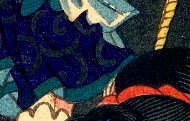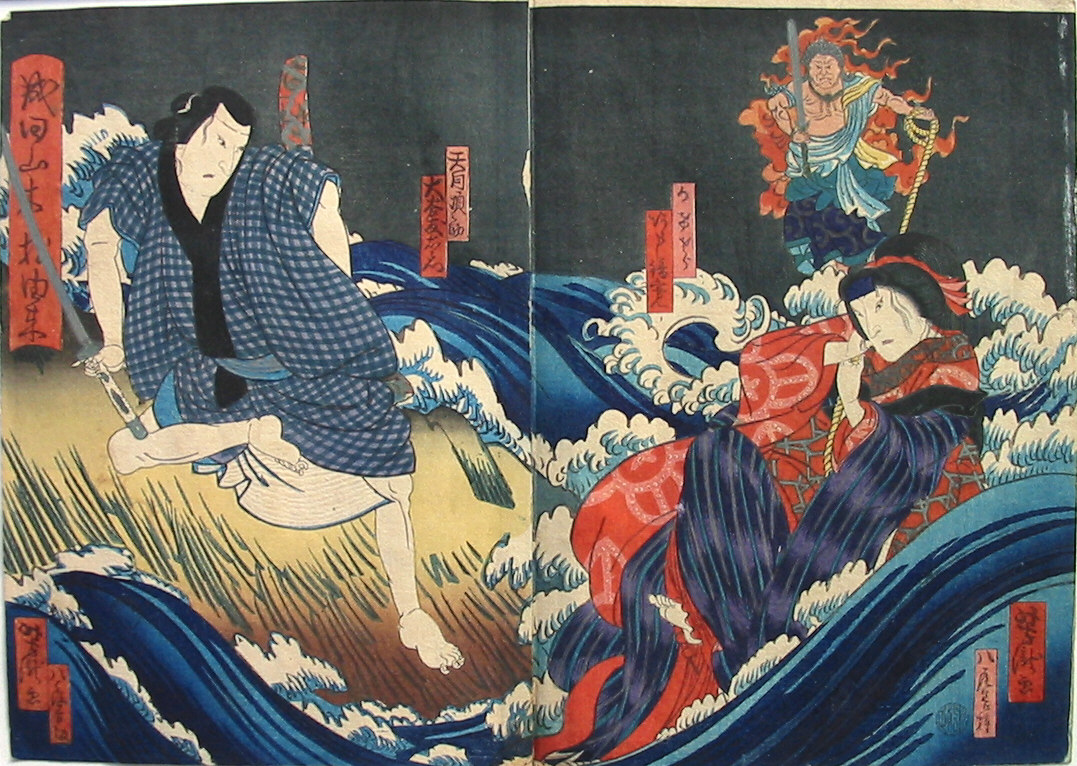 |
JAPANESE PRINTS
A MILLION QUESTIONS
TWO MILLION MYSTERIES
Ukiyo-e Prints浮世絵版画 |
|
formerly Port Townsend, Washington now Kansas City Missouri |
|
UTAGAWA YOSHITAKI |
|
歌川芳滝 |
|
1841-1899 |
|
Play: Naritasan ki fuda no yurai |
|
成田山木札由来 |
|
On the right: Arashi Rikan IV |
|
嵐璃寛 as Lady Kakesara |
|
On the left: Ōtani Tomoemon as Tenmoku cho no suke |
|
大谷友右衛門 AS 天目頂之介 |
|
Signed: Yoshitaki ga |
|
Date: 1871, 8th Month |
|
Meiji 4 |
|
明治4 |
|
Chuban diptych |
|
Combined Diptych Print Size: 9 7/8" x 13 7/8" |
|
There is another copy of this diptych in the collection of Waseda University on-line. |
|
SOLD! THANKS K! |
|
|
|
FUDŌ MYŌŌ 不動明王 The Immovable A Manifestation of Mahavairocana |
|
|
|
Volumes could be written about Fudō and some of it might even be comprehensible to the normal reader. However, much of it is muddled by references to Buddhist esoterica with lists of names which mean little or nothing to anyone but the most hardcore experts.
But at the risk of losing you here I think a little background can be helpful. According to the entry by Tsuchida Tomoaki in the Kodansha Encyclopedia of Japan (1983 edition, vol. 5, p. 291) the myōō or five kings of light and wisdom are the third most significant figures of the Buddhist hierarchy. In the first rank are the Buddhas followed by the Bodhisattvas or Buddhist saints. Among the five myōō Fudō is the most important. All five of the kings have their origin in figures from pre-Buddhist Hinduism. "They are considered to be incarnations of the cosmic Buddha who proselytize and save obdurate nonbelievers with the power of sacred words..."
The most prominent temple devoted to Fudō was (is) at Narita and many people made a pilgrimage there. One family which came to have particular ties to that place were the Ichikawa acting clan --- especially the Danjūrōs. Neither of the featured actors in the print shown on this page are Ichikawas. |
|
|
| THE PASSIONATE TOE | ||
| Detail to the right of the lower part of the Fudo figure showing just a bit of bared flesh. |
 |
|
|
Last night, June 12, 2004, I was reading about ukiyo paintings. In an entry by Professor Melinda Takeuchi describing a hanging scroll by Hishikawa Moronobu (ca. 1661-1694) of an elegantly robed beauty she noted the religious nuance of the raised big toe of the woman: "...the raised toe of the fierce deity Fudo, for example, signifies passion."
This came like a bolt out of the blue. I didn't know that. It sent me scurrying about looking for this diptych because I remembered that there was a touch of flesh toward the bottom of the image of Fudo, but what I couldn't remember was if it was a raised toe or not. I looked at my web page, but that was inconclusive. So, I found the print and I am sad to say that it only shows a bit of a bare shin. No feet, no toes. Sorry.
Professor Takeuchi also noted the use of hand gestures which mimicked the Buddhist mudras. Those I could understand, but not the toes. Linking such a feature to passion is reasonable, but rather odd. However, after some thought I recalled that anyone who has ever endured the dentisit drill must be aware of the curling and uncurling of their toes which is not unlike the white knuckle affect. But passion...? |
||

